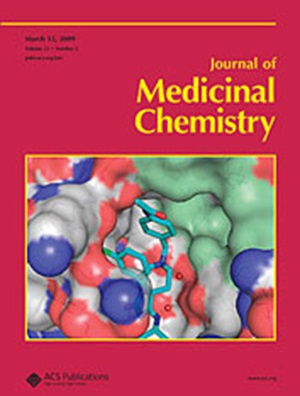Exploring the Phototherapeutic Applications of Mitochondria-Targeted COUPY Photocages of Antitumor Drugs
IF 6.8
1区 医学
Q1 CHEMISTRY, MEDICINAL
引用次数: 0
Abstract
Photocleavable protecting groups hold great promise in photopharmacology to control the release of bioactive molecules from their caged precursors within specific subcellular compartments. Herein, we describe a series of photocages based on a COUPY scaffold, incorporating chlorambucil (CLB) and 4-phenylbutyric acid (4-PBA) as bioactive payloads that can be efficiently activated with visible light. Confocal microscopy confirmed the preferential accumulation of CLB and 4-PBA N-hexyl COUPY photocages in the mitochondria, which exhibited a remarkable phototoxicity against cancer cells upon green-yellow light irradiation, with IC50 values in the nanomolar range. This effect was attributed to a synergistic mechanism involving the photorelease of the bioactive payloads and the intrinsic photogeneration of Type I and Type II ROS by the COUPY scaffold within mitochondria. Thus, COUPY-caged derivatives of CLB and 4-PBA underscore the potential of COUPY-caging groups as a versatile platform to develop innovative light-activated agents operating simultaneously through photodynamic therapy and photoactivated chemotherapy.

线粒体靶向抗肿瘤药物COUPY光笼的光疗应用探讨
光可切割保护基团在光药理学中具有很大的前景,可以控制生物活性分子从特定亚细胞区室的笼状前体释放出来。在此,我们描述了一系列基于COUPY支架的光笼,将氯苯(CLB)和4-苯基丁酸(4-PBA)作为生物活性有效载荷,可以被可见光有效激活。共聚焦显微镜证实了CLB和4-PBA n-己基COUPY光笼在线粒体中的优先积累,在黄绿色光照射下对癌细胞表现出显著的光毒性,IC50值在纳摩尔范围内。这种效应归因于线粒体内COUPY支架的生物活性载荷的光释放和I型和II型ROS的内在光生成的协同机制。因此,CLB和4-PBA的couy笼化衍生物强调了couy笼化基团作为开发创新光活化药物同时通过光动力治疗和光活化化疗的多功能平台的潜力。
本文章由计算机程序翻译,如有差异,请以英文原文为准。
求助全文
约1分钟内获得全文
求助全文
来源期刊

Journal of Medicinal Chemistry
医学-医药化学
CiteScore
4.00
自引率
11.00%
发文量
804
审稿时长
1.9 months
期刊介绍:
The Journal of Medicinal Chemistry is a prestigious biweekly peer-reviewed publication that focuses on the multifaceted field of medicinal chemistry. Since its inception in 1959 as the Journal of Medicinal and Pharmaceutical Chemistry, it has evolved to become a cornerstone in the dissemination of research findings related to the design, synthesis, and development of therapeutic agents.
The Journal of Medicinal Chemistry is recognized for its significant impact in the scientific community, as evidenced by its 2022 impact factor of 7.3. This metric reflects the journal's influence and the importance of its content in shaping the future of drug discovery and development. The journal serves as a vital resource for chemists, pharmacologists, and other researchers interested in the molecular mechanisms of drug action and the optimization of therapeutic compounds.
 求助内容:
求助内容: 应助结果提醒方式:
应助结果提醒方式:


